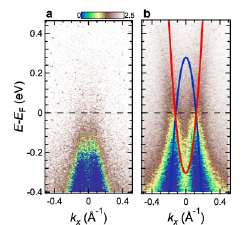Photo-Induced Semimetallic States Realized in Electron–Hole Coupled Insulators
K. Okazaki, T. Mizokawa, and S. Shin
Using light to manipulate materials into desired states is one of the goals in condensed matter physics, since light control can provide ultrafast and environmentally friendly photonics devices. However, it is generally difficult to realize a photo-induced phase which is not merely a higher entropy phase corresponding to a high-temperature phase at equilibrium.

Fig. 1. TARPES spectra of Ta2NiSe5 before and after pumping. a Energy–momentum (E–k) map before pumping, integrated in the time interval [−0.29, 0] ps. b Corresponding map of the transient states, integrated in [0, 1.2] ps. Red and blue parabolas indicate the electron and hole bands crossing EF in the non-equilibrium metallic state. These spectra were acquired with a pump fluence of 1.56 mJ/cm2.
Here, we report realization of photo-induced insulator-to-metal transitions in Ta2Ni(Se1−xSx)5 including the excitonic insulator phase using time- and angle-resolved photoemission spectroscopy (TARPES) [1]. From the dynamic properties of the system, we determine that screening of excitonic correlations plays a key role in the timescale of the transition to the metallic phase, which supports the existence of an excitonic insulator phase at equilibrium. The nonequilibrium metallic state observed unexpectedly in the direct-gap excitonic insulator opens up a new avenue to optical band engineering in electron–hole coupled systems.
Figure 1 shows the time-integrated TARPES spectra before and after pumping. After photo-excitation, both the electron and hole bands cross EF at the same Fermi momentum kF ~0.1 A−1 as schematically shown by the red and blue parabolas in Fig. 1b. This may indicate that the hybridization between the two Ta chains is sufficiently strong to lift the degeneracy. However, since this is not predicted by band-structure calculations, this behavior of the emerging of the hole and electron bands crossing EF at the same kF is a surprising nature of the observed non-equilibrium metallic phase, indicating that the observed nonequilibrium metallic state is entirely different from the high temperature phase in the equilibrium state.
To confirm that the observed non-equilibrium metallic phase of Ta2NiSe5 can be associated with the excitonic condensation, we have performed comparative TARPES measurements on Ta2NiS5. Quite unexpectedly, an electron band emerges above EF and the hole band below EF shifts upward. In addition, the bottom of the electron band and the top of the hole band seems to cross EF, and the system seems likely to be semimetallic. This may require reconsidering the nature of the insulating phase for Ta2NiS5, which had been considered as an ordinary band insulator.
The non-equilibrium metallic phases observed for both of Ta2NiSe5 and Ta2NiS5 should suggest that these photo-induced phase transitions are not merely transitions to higher entropy states that can be realized at high temperatures in the equilibrium state. Thus, photo-excitation can be considered to induce similar effects to pressure. Since the pressure-induced superconducting phase has been found for Ta2NiSe5, with some appropriate pumping condition probably with lower photon energy of some resonant condition, photo-induced superconductivity might be realized for this material. Realization of this fascinating photo-induced phase would be one of the ultimate goals of investigations of the photo-excited electronic state.
References
- [1] K. Okazaki, Y. Ogawa, T. Suzuki, T. Yamamoto, T. Someya, S. Michimae, M. Watanabe, Y.-F. Lu, M. Nohara, H. Takagi, N. Katayama, H. Sawa, M. Fujisawa, T. Kanai, N. Ishii, J. Itatani, T. Mizokawa, and S. Shin, Nat. Commun. 9, 4322, (2018).
